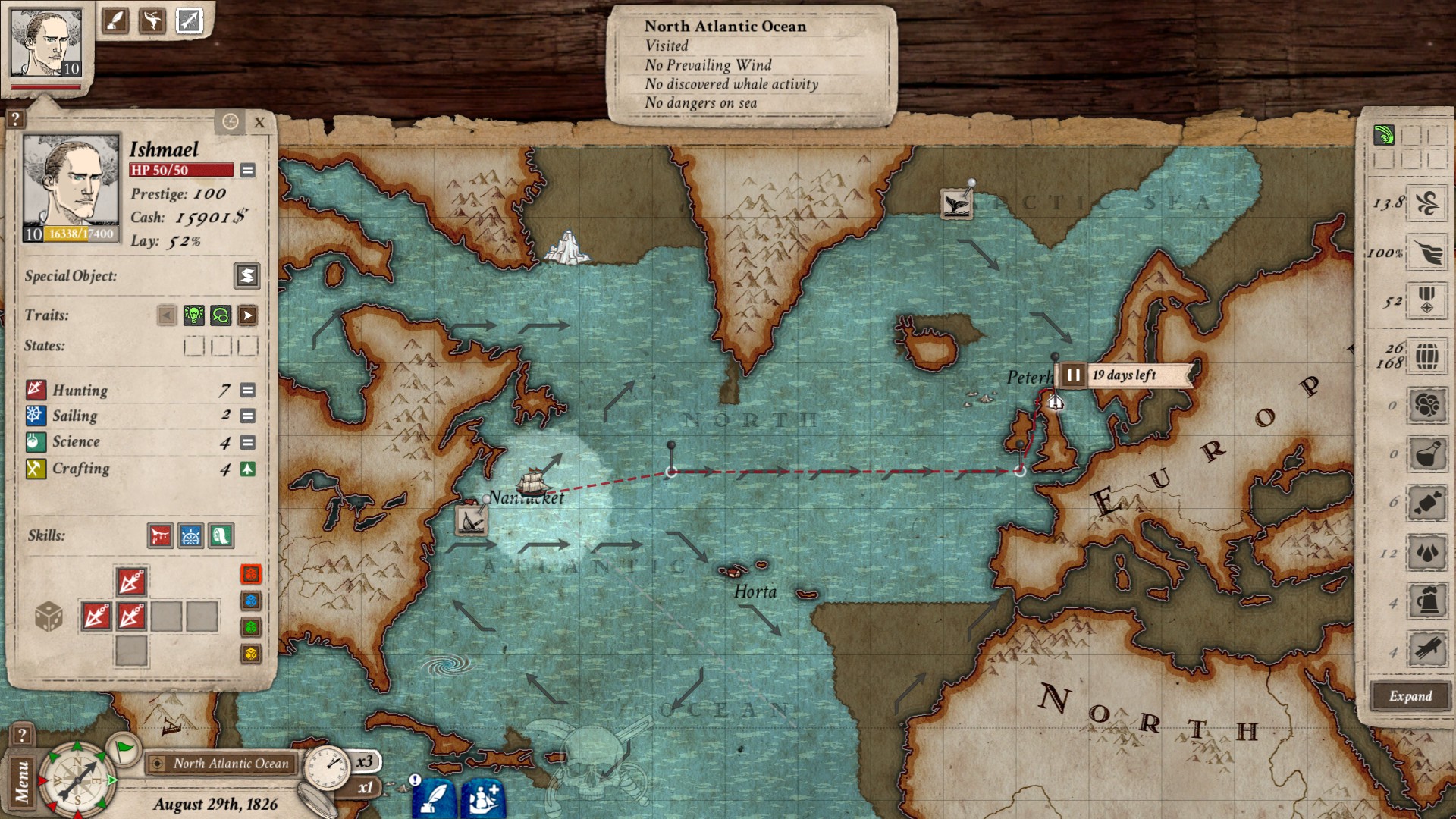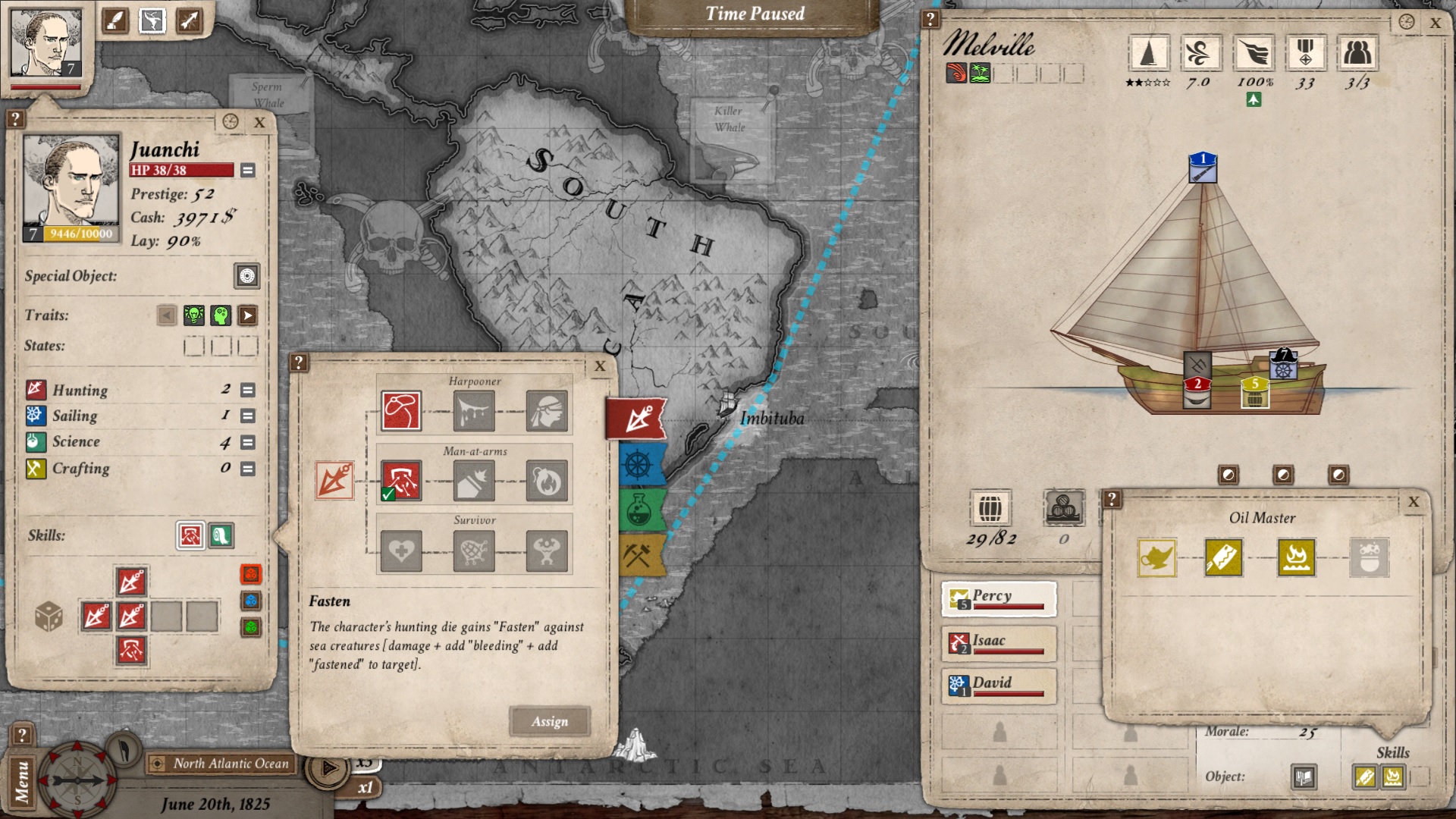Nantucket review
Italian game studio Picaresque delivers its first title.

Basing its main storyline on the events that take place after the ending of the classic novel Moby Dick, Nantucket takes us back to the whale hunting era of the first half of the 19th century. We take the role of Ishmael, a few years after the perishing of the Pequod, during which Captain Ahab and his crew lost their final battle – and their lives – against the iconic Moby Dick. Developed by the italian studio Picaresque, Nantucket is a seafaring, strategy and role-playing game with great ambiance, a very interesting set-up but that relies on repetitive gameplay in order to deliver answers and real progress.
We, as the players, will command Ishmael (although we are given the choice of changing our character name) through his mission of revenge on the monstrous white whale, being the captain of an initially small ship with few crew members who will need to improve their abilities and experience in order to be of any use in this odyssey.

The first couple of hours on Nantucket fill the purpose of a tutorial on how to manage our resources (such as water, food, wood, grog and the main value object of the game, blubber), gather more of them, recruit new crew members and track assignments. We are presented with a map of the world, completely unexplored and with the promise of a rewarding exploration experience. Hunting different types of whales will be our main activity throughout the game, which will provide us with blubber to sell, food to keep our crew alive and experience to get new skills from a brief but solid skill tree.
At that point, finding out what happened to a missing ship, check if the rumours of a new whaling area are true or delivering some goods from point A to point B will be a well-delivered adventure. I found myself looking at the map and thinking which course was best: the long and tedious one, or the fast and risky with danger of pirates trying to board my ship. The sound effects reflect perfectly the movement of the ocean and the relaxing scraping of the ropes while the wind pushes you forward. I particularly enjoyed the sea ballads and shanties, sometimes wishing my present journey was a long one so that I could finish listening to a particular song.
Combat is a dice-driven sequence where we will have to choose our better-fitted crew members to join us in the whaling boat (or just let them go without you, in which case at least one of them will probably die) and face either whales, pirates or “other” (spoiler-free term). Depending on which skills our team has, we will be able to select which type of dice we will use. We can use combat dice to harpoon or shoot our way out of danger; sailing dice to manoeuvre and repel attacks; science dice to heal or revive injured or dead allies; or crafting dice to, for example, reroll.
But after a while, everything starts to feel repetitive. The assignments are low in diversity and hunting on a whaling area to gather more blubber to sell at the nearest port is a constant repetition of variables. Also, we are shown some dialogue options from time to time within our long trips in which we will be presented with different choices and answers, depending on which traits and skills we have as captains, that will slowly begin to also feel kind of monotonous and without meaningful consequences. There is some balance in this regard when, for example, one of our crew members dies in combat or after maneuvering inside one of the ocean’s many dangers (such as tropical storms, icebergs and perilous seabeds) and we get that Darkest Dungeon or XCOM feeling of permadeath, that somehow it was our fault and we must rebuild our team. Actually, we are given the option of a more definitive permadeath experience when starting a new game. In this mode our captain will die permanently and we will need to restart our adventure, as if in a roguelike game like The Curious Expedition.

Progression is hard to get. With the many ways in which things can go wrong and the amount of time needed to level up our crew, or even buy a ship that allows us to hire more sailors and carry more equipment and goods, being able to pursue the elusive Moby Dick is going to start feeling like a distant dream. The main antagonist of the story has so little relevance in the general experience that its avatar in our imagination will slowly fade away.
Granted, whenever you hit an upgrade milestone, like replacing your tiny boat with a more aggressive and intimidating clipper, energies will recharge and you’ll be wanting to test your new rig with every creature, pirate or mysterious danger out there. You’ll want to take on those tasks at that dock on the other side of the map that you couldn’t afford facing before. You’ll want to chase that rumour on the whereabouts of your lifetime enemy and get revenge once and for all.
So even if it may feel repetitive for long stretches of gameplay, the sense of reward for putting so much effort into your adventure and having the patience of waiting for the right moment to engage that area you were avoiding because you knew you weren’t ready will be worth it.
The art style and the faithfulness to the setting of Moby Dick as a classic novel are also aspects to value. “It’s been a long journey,” Picaresque designer Marco Mantoan says, “but during the past few months of beta testing we have felt our community near us, helping us to deliver what we believe is a unique glimpse of the world narrated by Herman Melville in Moby Dick.”
Priced at £13.99 / €17.99 / $17.99, Nantucket is available now via Steam, Humble Store, GOG, GamersGate, Green Man Gaming, Fanatical, Indiegala and other digital stores.

